Here
is a wonderful array of early Heddon lures that were found in a
basement in California. Most were never rigged with hooks because they
were part of a salesman sample case used to show retailers the current
line of Heddon fishing lures. They include Heddon 150 Dowagiac Minnows,
Heddon Jointed Vamp lures, Tadpolly, Lucky 13, Heddon Vamp lures, Heddon
Basser lures and Gamefisher baits. |
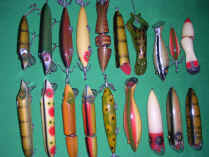 |
|
This is a Heddon 210 Surface lure in a
special and rare color called bumble bee. From what I can tell this finish
appeared intermittently over a short time frame in the 1920s, perhaps by
special order. This Heddon 210 Surface lure came from a tackle box owned by a man who died
near the end of World War II. The box was given to a relative, who taped
it shut and didn't open it until 1995, when its contents were acquired for
this collection. |
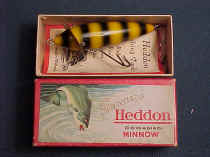 |
The
Heddon Darting Zara was a takeoff on
the pointy nosed Zaragossa. Both were tailored to bass fishing in
Florida. This early L-rigged version dates to around 1928, when these
interesting lures were introduced. Most Heddon Darting Zara lures are in the
later two-piece hardware rigging. This one has a tiny metal pin in the
joint of the nose. The red eye shadow is wonderful. The Zara Spook came
along much later. Zara Spook lures are plastic while the Darting Zara is
wood. Zaragossa lures are even rarer. |
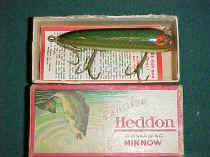 |
Heddon flyrod lures came packaged
in their own tiny boxes. This flyrod Flaptail is actually a miniature
wooden lure, complete with metal flapping tail. Usually, these are found
with the hand-tied feathers damaged or removed. The small "upleaping" bass
box dates to the late 20s and into the 30s, and succeeded the "downleaping"
bass boxes. This flyrod Flaptail inside is in mint condition. |
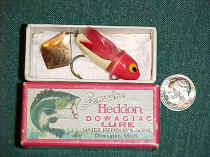 |
|
The Wilder-Dilg lures originated
in 1923 and were named after B.F. Wilder and Bill Dilg, both note fly
fishermen. This is the "introductory" box with no leaping bass logo. The
larger Wilder Dilgs came in boxes with portraits of famous anglers on
their covers. The flyer in the box includes fishing instructions. The
Wilder-Dilg caught fish. |
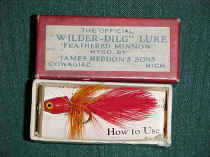 |
|
This trout sized Wilder-Dilg is in
the more common and traditional downleaping bass box from the 1920s. These
tiny boxes sometimes turn up in tackle boxes filled with swivels, split
shot or other small items. Never overlook a tiny box. |
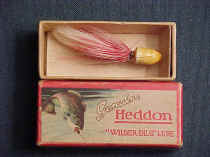 |
|
Here are three Heddon Wilder-Dilg
lures all new in their original boxes. The Wilder-Dilg lure came in 12
patterns and each was named after a famous angler who was also a friend of
the Heddon family. They included Capt. Samson, Mannfield's Coaxer,
Kemper's Charge, Irvin Cobb, Wilder's Fancy, Peet's Choice, Zane Grey,
Gifford Pinchot, Brann's Glory, Dilg's own and Bob Davis. |
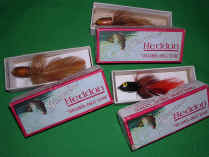 |
|
Here is a gorgeous new in box
(including an extra Wilder-Dilg lure) Gifford Pinchot flyrod lure. This is
the special "intro box" that each of the 12 versions was first
offered in. Although most boxes have a portrait of the angler on the top,
this is the only one of the 12 that, for some unknown reason, has no
mugshot! Maybe Gifford Pinchot didn't like to have his picture
taken. |
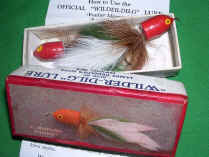 |
|
Here is another Wilder-Dilg box
with the No. 4 Kemper's Charge lure inside, along with an extra lure. It
would be a challenge to assemble all 12 of these beautiful early
boxes. |
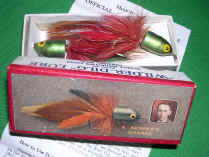 |
The
Heddon Bass Bug and Heddon Baby Bass Bug came out in the 1920s in
beautiful little downleaping bass boxes. The four mint specimens shown
here were acquired from a visitor to this website, and include No.
56 Chadwick's Sunbeam, No. 57 Ozark Ripley, No. 52 Brann's Ranger and
No. 59 Clark's Fancy. These baits are like miniature works of art, and
they caught fish too. Baby Bass Bug lures are harder to find than the regular Heddon Bass
Bug. |
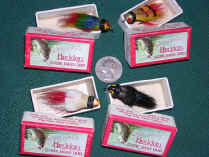 |
|
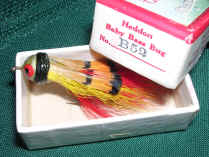 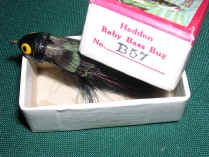
|
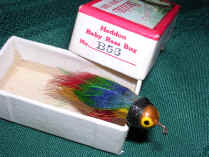 |
Far from the tiny flyrod
Heddon Bass Bug boxes are
the bigger cartons made for Heddon's musky baits. This "Muskiteer Vamp,"
as the endflap says, is a big bait. The downleaping bass box with the end
label printed on the top is referred to as the "stretch" box. The lure is
finished in Natural Scale, one of Heddon's prettiest colors. The Heddon
Vamp is a fine lure and the Musky Vamp was made for many years. |
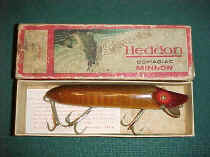 |
|
This jointed Giant Vamp, or Great
Vamp, is
finished in Allen Stripey finish, characterized by the red head tapering
to a long side stripe on each side. The "Man Holding Bass" style box
for this Giant Vamp dates
this piece to the late 1930s. This bait has Heddon toilet seat hardware, typical
of that era. |
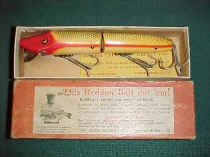 |
|
This is a 110 series glass-eyed
Heddon River Runt, the forerunner of the common plastic lures called River Runt
Spooks. This color is called Dace, and the red bordered upleaping bass box
dates this minty example to the early or mid-1930s. This was a gift from a
friend in Arizona. |
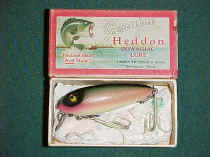 |
|
The Heddon Lucky 13, introduced
around 1920, was a fixture in Heddon's product line well into the 1960s.
This glass eyed example finished in Perch Scale dates to the mid-1930s.
This Lucky 13 has two-piece hook hardware and comes in a Man Holding Bass box,
or "Brush Box," named after the man on the cover. |
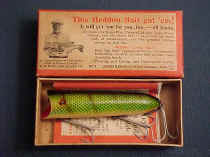 |
|
The later Heddon baits made into
the 1950s were packaged in this style box with the bass leaping up, and
the muted rectangle Heddon logo. These pretty boxes are easy to find, but
still desirable. The tag indicates this King Basser lure was packaged in
October 1952 by the E.K. Tryon Co. for the U.S. Navy. The King Basser was also
made in a bass size. |
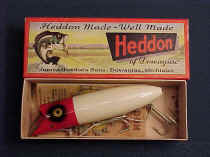 |
The
is another example of the later Heddon "banner box" from the
1950s. Inside is a beautiful, unfished No. 150 Dowagiac Minnow with five
hooks. Note that this later version has painted eyes (not glass) and the
later "surface rig" hook hardware. The box is correctly marked
150 RET (stands for Red Eyes & Tail) and was a gift to this
collection from a kind visitor who happened across this
website. |
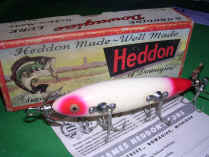 |
|
This Tadpolly lure from the 1920s
is finished in Bar Perch, one of Heddon's early colors that vanished in
the late 1920s. We found this Tadpolly in a junk shop while lure-hunting in
central Maine. This is my all-time favorite lure color. If you think this
bait is pretty, put on your sunglasses and enter the next page. |
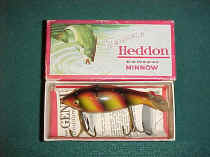 |